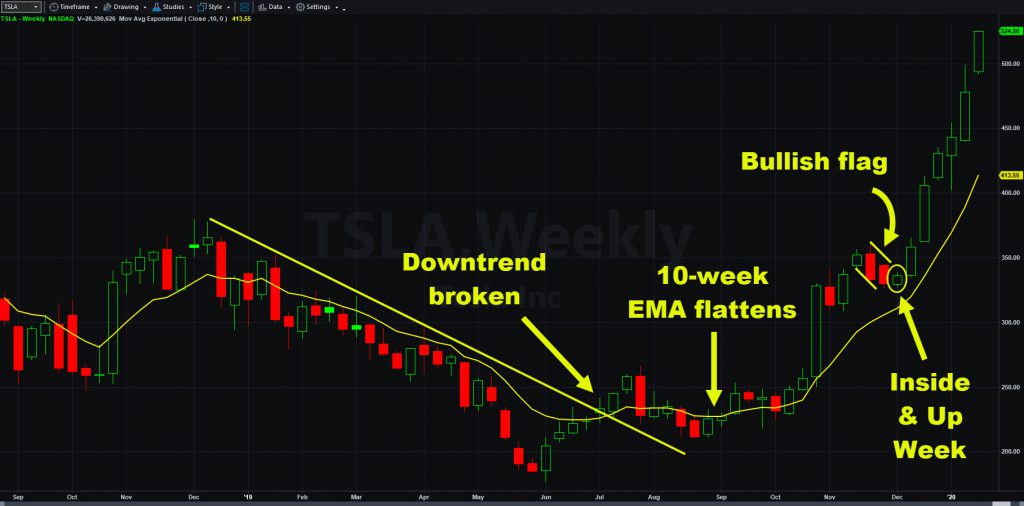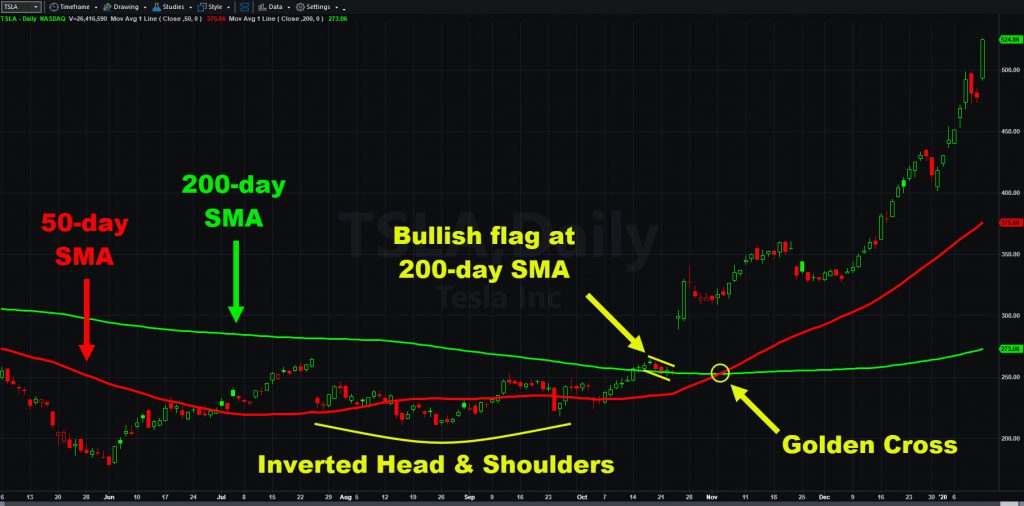Never argue with price action. Look no further than Tesla for an example of why traders love technical analysis.
If you haven’t noticed, Elon Musk’s electric-car disrupter made a dramatic U-turn last year. It’s more than doubled since the summer, punishing short sellers and naysayers along the way. There were some fundamental reasons, but the real signals were most obvious on the price charts technical analysts love.
The first inklings of the rebound came in July, when TSLA broke a downward trend line. That didn’t mean a lot by itself because the stock continued to chop around. But it was a start.
Next was an easing of volatility. Price movements got smaller as the shares moved sideways. Its 10-week exponential moving average (EMA) also flattened out, another sign that the first half’s vicious downtrend was over.
The Big Turn
Now came the key litmus test. After all, stocks often pause after moving lower. Then after a period of time, they keep falling. Just look at retailers like Macy’s (M) or L Brands (LB) last spring. How did the charts tell us that TSLA was reversing, and not just consolidating before another drop?

One big pattern stood out first: an inverted head and shoulders.
On September 25, TSLA bounced at $218.36. That was higher than its low of $211 a month earlier. Take a step back to look at a little more history, and you’ll also see a low of $222.25 on July 26.
A low, followed by a lower low and then a higher low. Translation: “We tried to break down, but we just couldn’t do it.” The reversal starts to look real.
Next came a bull flag in late October. The stock was moving sideways and slightly lower after advancing. That kind of pause inside of a rally is often followed by new highs. It also occurred at the 200-day simple moving average (SMA). Going above that resistance zone could result in a breakout.
Earnings, which are very difficult to trade, came next. We never know what a company is going to announce, so a lot of traders avoid these binary events and look for opportunities when they have more of an edge.
Inside and Up
Such a moment came about six weeks later when my favorite pattern appeared. But before it did, TSLA crossed another milestone in its transformation from bear to bull.
On November 5, the 50-day SMA rose above the 200-day SMA. Known as a golden cross, this widely followed pattern often marks a significant change in character.

But just because a stock is going higher doesn’t mean you should buy it. Trading is a disciplined skill. We should wait for key entry points where the odds of profit significantly outweigh the risk of loss.
One such occasion occurred soon enough when the weekly chart went “inside and up.” What does that mean?
First is the inside candle. One week’s movement fits entirely within the previous period. A lower high and a higher low for the week means that movement is narrowing.
Second, the inside candle closed above the previous week. That shows buyers took control.
Pedal to the Metal
TSLA pulled this trick December 2-6. It also occurred within another bullish flag on the weekly chart, as the stock paused after the earnings surge. That “inside and up” candle was a green light for the bulls. They put the pedal to the metal the following Monday and the stock burned rubber straight to the upside.
Three weeks later, it was firmly above $400 for the first time ever. Another four weeks, and $500 was in the rearview mirror.
Looking back at TSLA’s monster rally, we can take away some important lessons.
The first is that traders need to focus heavily on charts. Fundamentals like earnings certainly matter, but they usually manifest themselves in price action.
Next, we always need to be flexible because we’re not sure when and where and entry will occur. Traders chasing the high after earnings would have made money, but only after two weeks of drawdowns. Waiting for the right signal prevents you from getting stopped out in the meantime. It also keeps your capital available for other opportunities.
Finally, even if you missed TSLA’s epic move, you can still resolve to profit from similar opportunities in the future. It’s never too late to learn and become a better trader.























